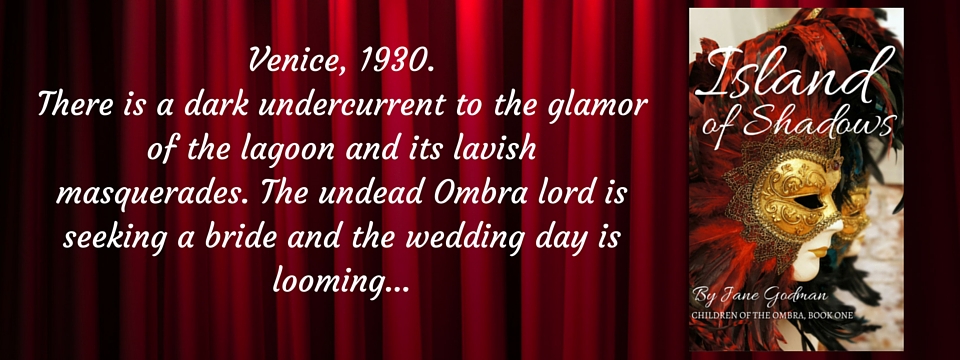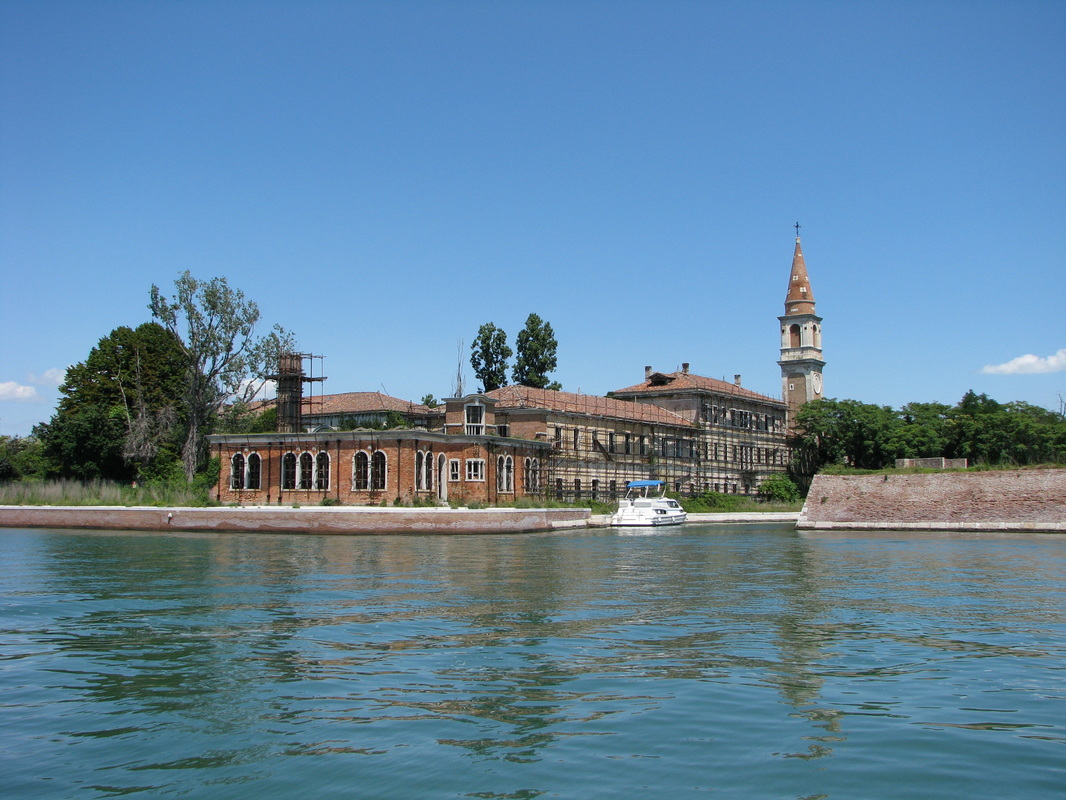The Venetian lagoon is sprinkled with jewels, and one of them, of course, shines brighter than all the others put together. But just five miles from the dazzling gem that is Venice there sits a lonely, black opal. Its name is Poveglia. In contrast to its fascinating neighbor, it is silent and abandoned. An uninhabited, forbidden island. No tourists flock to these shores for romantic meals or gondola rides. There are no palaces or elegant bridges. And the differences don’t end there. Poveglia does not share Venice’s carnival mood, colors, heady scents and bright lights. There are no masquerades or festivals on Poveglia. No dancing in the streets.
Known as the most haunted place on earth, Poveglia’s history reads like a horror story. It has been a quarantine station, a dumping ground for plague victims, a mental institution where a butcher experimented on the inmates…
It is said that so many people were burned and buried there that the soil is mostly human ash, that the local fishermen will not trawl its waters for fear of netting the bones of their ancestors, and that the psychiatrist who ran the hospital was strangled by a ghostly mist. Rumors abound, fueled by the fact that, even though Poveglia is a mere boat ride from Venice, it is almost impossible to visit the island. What caused this island’s history to become so tainted that it is spoken of only in whispers?
The History of Poveglia
The first reference to the island can be found in the year 421, when people from Padua and Este fled there to escape the barbarian invasions. In 809, the residents heroically blocked the advance of the Frankish army into the Venetian lagoon. In 864, when Doge Pietro Tradonico was murdered by opposing Venetian nobles, several hundred of his followers fled to Poveglia. This increase in the island’s population earned it the status of podestà, or administrative municipality.
In 1015, the Romanesque church of San Vitale was built on Poveglia with an attached monastery, and under this stabilizing influence, a small community of houses, gardens and vineyards thrived. Poveglia knew peace for close to four centuries, due largely to the rights conferred on its inhabitants to guide ships in and out of the harbor of Malamocco on the Lido.
In 1379, during the War of Chioggia between the Venetian Republic (the Serenissima) and Genoa, the government moved the whole population of Poveglia to another island, Giudecca. It is not clear whether this was to protect them, or because they were conniving with the enemy. A permanent fortification called the Octagon, which is still visible today, was built on strategically important Poveglia.
Poveglia’s story took another sinister turn in 1468 when the Venetian Republic designated the island as a lazaretto. Named after the biblical leper, Lazarus, a lazaretto was a place of confinement and isolation for carriers of contagious diseases, particularly of leprosy and plague. Thus, Poveglia became a quarantine station for the many ships entering the Laguna Veneta. Any vessels that were suspected of bearing plague, or other potentially infectious diseases, were detained at anchor just off the island’s shores until the authorities were satisfied that no contamination would be spread to the residents of Venice itself.
Poveglia began to pose a problem for the Most Serene Republic of Venice. Fishermen shunned the lagoon waters around its shores. Despite the fact that the fertile soil was ideal for growing grapes and olives, farmers always found compelling reasons why it would be better to settle elsewhere. In an attempt to reverse its reputation, in 1527 the Doge offered the island to the Camadolese monks. The monks refused.
With the arrival of the Black Death in 1576, thousands of dead bodies piled up in the streets of Venice. The stench of disease was appalling. The solution was to take the bodies to Poveglia and dump them in large pits or burn them on huge bonfires. As the bubonic plague tightened its grip on the Serene Republic, people panicked, and those showing even the slightest symptoms were dragged screaming from their homes and into waiting barges. At least one hundred thousand people were said to have died on Poveglia, forcibly transported there from their Venetian homes. Once the boats reached Poveglia, the dead were taken over the bridge to the plague-pits while the living took their chances in the ruins of the medieval settlement. As the epidemic intensified, the island became so overcrowded that the living were flung into burial pits or pitchforked onto bonfires along with the dead.
In 1630, health measures were relaxed during the season of the carnevale, leading to another outbreak of plague. The city of Venice was severely hit, with recorded casualties of 46,000 people out of a population of 140,000. Poveglia was once more used as the lazaretto. In 1661 the Doge offered the descendants of the original islanders the chance to move back to Poveglia and to rebuild their homes. They refused.
In 1805, under Napoleon’s rule, the church that had been on Poveglia for centuries was destroyed and the bell tower converted into a lighthouse. This razing of the last testament of its inhabited past marked the island’s grim entry into the modern era.
In 1922 the island became home to a psychiatric hospital. The patients of the hospital reported that they could see ghosts of plague victims on the island and that they were kept awake at night by the tortured wails of the suffering spirits.
The story is that the doctor in charge decided to make a name for himself by experimenting on his subjects to find a cure for insanity. Lobotomies were performed using crude tools like hand drills, chisels, and hammers. Patients were taken to the bell tower where they were tortured and subjected to a number of inhumane horrors.
According to Poveglia folklore, after many years of performing these immoral acts, the evil doctor succumbed to the madness and began to see and hear the plague ridden spirits himself. It is said that he threw himself from the bell tower, but he didn’t die. According to a nurse who witnessed the incident, as he lay on the ground writhing in pain, a ghostly mist came up out of the ground and choked him to death. The hospital was closed in 1968 and Poveglia has been abandoned ever since.
In 2014, Poveglia was put up for auction and bought for the sum of €513,000 (roughly $704,000) by Italian businessman Luigi Brugnaro. Opposition to Brugnaro’s bid from the community group Poveglia per Tutti (Poveglia for All), and the fact that Brugnaro is now Mayor of Venice, brought an end to his plans. At present, the future of the island remains undecided.
Poveglia is the inspiration and setting for my gothic romance Island of Shadows.
Known as the most haunted place on earth, Poveglia’s history reads like a horror story. It has been a quarantine station, a dumping ground for plague victims, a mental institution where a butcher experimented on the inmates…
It is said that so many people were burned and buried there that the soil is mostly human ash, that the local fishermen will not trawl its waters for fear of netting the bones of their ancestors, and that the psychiatrist who ran the hospital was strangled by a ghostly mist. Rumors abound, fueled by the fact that, even though Poveglia is a mere boat ride from Venice, it is almost impossible to visit the island. What caused this island’s history to become so tainted that it is spoken of only in whispers?
The History of Poveglia
The first reference to the island can be found in the year 421, when people from Padua and Este fled there to escape the barbarian invasions. In 809, the residents heroically blocked the advance of the Frankish army into the Venetian lagoon. In 864, when Doge Pietro Tradonico was murdered by opposing Venetian nobles, several hundred of his followers fled to Poveglia. This increase in the island’s population earned it the status of podestà, or administrative municipality.
In 1015, the Romanesque church of San Vitale was built on Poveglia with an attached monastery, and under this stabilizing influence, a small community of houses, gardens and vineyards thrived. Poveglia knew peace for close to four centuries, due largely to the rights conferred on its inhabitants to guide ships in and out of the harbor of Malamocco on the Lido.
In 1379, during the War of Chioggia between the Venetian Republic (the Serenissima) and Genoa, the government moved the whole population of Poveglia to another island, Giudecca. It is not clear whether this was to protect them, or because they were conniving with the enemy. A permanent fortification called the Octagon, which is still visible today, was built on strategically important Poveglia.
Poveglia’s story took another sinister turn in 1468 when the Venetian Republic designated the island as a lazaretto. Named after the biblical leper, Lazarus, a lazaretto was a place of confinement and isolation for carriers of contagious diseases, particularly of leprosy and plague. Thus, Poveglia became a quarantine station for the many ships entering the Laguna Veneta. Any vessels that were suspected of bearing plague, or other potentially infectious diseases, were detained at anchor just off the island’s shores until the authorities were satisfied that no contamination would be spread to the residents of Venice itself.
Poveglia began to pose a problem for the Most Serene Republic of Venice. Fishermen shunned the lagoon waters around its shores. Despite the fact that the fertile soil was ideal for growing grapes and olives, farmers always found compelling reasons why it would be better to settle elsewhere. In an attempt to reverse its reputation, in 1527 the Doge offered the island to the Camadolese monks. The monks refused.
With the arrival of the Black Death in 1576, thousands of dead bodies piled up in the streets of Venice. The stench of disease was appalling. The solution was to take the bodies to Poveglia and dump them in large pits or burn them on huge bonfires. As the bubonic plague tightened its grip on the Serene Republic, people panicked, and those showing even the slightest symptoms were dragged screaming from their homes and into waiting barges. At least one hundred thousand people were said to have died on Poveglia, forcibly transported there from their Venetian homes. Once the boats reached Poveglia, the dead were taken over the bridge to the plague-pits while the living took their chances in the ruins of the medieval settlement. As the epidemic intensified, the island became so overcrowded that the living were flung into burial pits or pitchforked onto bonfires along with the dead.
In 1630, health measures were relaxed during the season of the carnevale, leading to another outbreak of plague. The city of Venice was severely hit, with recorded casualties of 46,000 people out of a population of 140,000. Poveglia was once more used as the lazaretto. In 1661 the Doge offered the descendants of the original islanders the chance to move back to Poveglia and to rebuild their homes. They refused.
In 1805, under Napoleon’s rule, the church that had been on Poveglia for centuries was destroyed and the bell tower converted into a lighthouse. This razing of the last testament of its inhabited past marked the island’s grim entry into the modern era.
In 1922 the island became home to a psychiatric hospital. The patients of the hospital reported that they could see ghosts of plague victims on the island and that they were kept awake at night by the tortured wails of the suffering spirits.
The story is that the doctor in charge decided to make a name for himself by experimenting on his subjects to find a cure for insanity. Lobotomies were performed using crude tools like hand drills, chisels, and hammers. Patients were taken to the bell tower where they were tortured and subjected to a number of inhumane horrors.
According to Poveglia folklore, after many years of performing these immoral acts, the evil doctor succumbed to the madness and began to see and hear the plague ridden spirits himself. It is said that he threw himself from the bell tower, but he didn’t die. According to a nurse who witnessed the incident, as he lay on the ground writhing in pain, a ghostly mist came up out of the ground and choked him to death. The hospital was closed in 1968 and Poveglia has been abandoned ever since.
In 2014, Poveglia was put up for auction and bought for the sum of €513,000 (roughly $704,000) by Italian businessman Luigi Brugnaro. Opposition to Brugnaro’s bid from the community group Poveglia per Tutti (Poveglia for All), and the fact that Brugnaro is now Mayor of Venice, brought an end to his plans. At present, the future of the island remains undecided.
Poveglia is the inspiration and setting for my gothic romance Island of Shadows.







 RSS Feed
RSS Feed